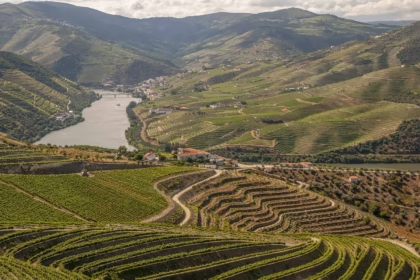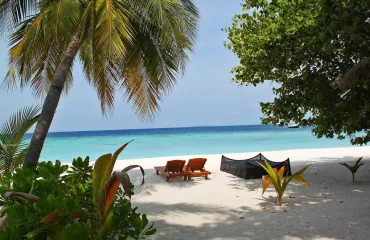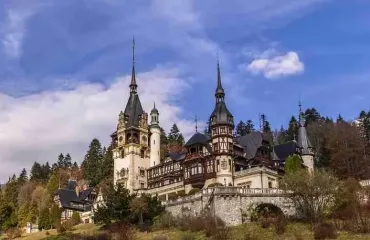
Howell and Jan Rees travelled to Portugal in April with Our Local Tour and kindly wrote the following account of their walking holiday in Portugal
A Walking Holiday in Portugal: Discovering the Douro Valley
Our journey began in Porto on a warm afternoon. The flight from Bristol had been slightly delayed, so our transfer wasn’t waiting when we landed. It didn’t take long, however, before we were on our way to the city centre. As we drove past FC Porto’s stadium and other landmarks, our friendly driver shared local insights that made the ride enjoyable.
Our hotel sat right on the river in the heart of Porto, giving us time to wander the cobbled streets and soak up the city’s charm before dinner. Following the hotel’s recommendation, we enjoyed a delicious meal and received our welcome pack, which included a guidebook, GPS app instructions, a power bank for our phones, and accommodation vouchers. Everything was thoughtfully prepared for the adventure ahead.
The next morning, we boarded a ferry at the quay for a scenic cruise up the Douro River to Pinhão. Breakfast on board was excellent, and the views were unforgettable. The river journey was spectacular, especially as we passed through towering locks and admired terraced vineyards clinging to the hillsides. Lunch featured generous servings of local red and white wine, a perfect introduction to Portuguese flavours. By late afternoon, we arrived in Pinhão and transferred to a charming hotel overlooking the village.
Since the hotel didn’t serve dinner, we strolled down to Pinhão and found a traditional Portuguese restaurant. The food was hearty, the wine flowed, and we savoured every bite, one of many highlights of our walking holiday in Portugal.
The following day marked the start of our walking adventure. Armed with a packed lunch from the hotel and guided by a GPS route on our smartphone, we set off into the hills. The app worked flawlessly, and the accompanying booklet provided maps, accommodation details, and notes on local highlights. The scenery was breathtaking. We wandered along cobbled lanes, through sleepy hamlets, and across gravel paths winding through vineyards.
Ancient stone walls lined the green roads, and late April brought wildflowers in full bloom. Swathes of yellow lupins painted the hillsides, adding bursts of colour to the landscape. Towards the end of the walk, we passed the entrance to Quinta Manhãs D’Ouro, our next hotel perched high above the Pinhão River. The views over the Douro and Pinhão valleys were spectacular, a reward for every step taken.
Our luggage had already arrived when we returned to the hotel, and dinner in the dining room was excellent.
The next day’s route led us deeper into the valley, following quiet lanes and vineyard trails with almost no traffic. The peace was remarkable, broken only by birdsong and the rustle of leaves. When we reached the river, heavy rain greeted us. The guidebook suggested this as a bailout point for those who didn’t fancy the steep climb ahead. Normally, we’d have continued, but the downpour convinced us to call a taxi, a wise decision that kept spirits high.
As the journey continued, the walks grew longer but remained just as rewarding. High in the hills above the Douro, we explored rugged landscapes dotted with olive groves and terraced vines. The guidebook recommended a stop at the Bread and Wine Museum in Favaios, and we were glad we followed that advice. For €1.50, we enjoyed a fascinating exhibit and a complimentary glass of Moscatel, a sweet treat that perfectly captured the essence of the region.
Our accommodation throughout the trip was exceptional. In Alijó, we stayed at Casa d’Arca, where our hostess welcomed us like family. Evening meals weren’t provided, but she secured us a table at a local restaurant despite May Day closures. The food was simple yet delicious, and the local wine served by the carafe was both affordable and excellent. Each night brought a new experience, from intimate guesthouses to historic manor houses. One of the most memorable was Casa de Casal de Loivos, a 17th-century property perched high above the confluence of the Douro and Pinhão rivers.
Dinner was served in a magnificent dining room around a long refectory table, where we shared great food, wine, and conversation with fellow travellers.
The final stretch of our walking holiday in Portugal took us downhill to Pinhão, with sweeping views of the Douro and its mosaic of vineyards. Our luggage awaited us in town, and after a quick bite, we boarded the train back to Porto. The journey hugged the river for much of the way, offering one last look at the valley’s beauty.
From Porto station, we took a taxi to our hotel, located further down the estuary. That evening, we explored more of Porto and enjoyed one last taste of Portuguese cuisine and wine, a fitting end to an unforgettable adventure.
Why Choose a Walking Holiday in Portugal?
The Douro Valley is a destination that combines natural beauty, cultural heritage, and world-class wine. Walking here allows you to experience it all at a slower pace. You’ll wander through terraced vineyards, discover historic villages, and enjoy authentic hospitality in family-run guesthouses. With expert planning, luggage transfers, and GPS-guided routes, the journey is stress-free yet full of adventure.
Ready to Plan Your Walking Holiday in Portugal?
At Our Local Tour, we specialise in creating itineraries that combine scenic walks, cultural experiences, and local flavours. Whether you want a short break or a week-long adventure, we’ll design a trip that suits your pace and interests. Get in touch today and start planning your walking holiday in Portugal. Let us help you discover the Douro Valley in a way you’ll never forget.
Many thanks to Howell and Jan Rees for the blog post on their walking holiday in Portugal.



